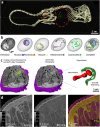X-ray computed tomography in life sciences
- PMID: 32103752
- PMCID: PMC7045626
- DOI: 10.1186/s12915-020-0753-2
X-ray computed tomography in life sciences
Abstract
Recent developments within micro-computed tomography (μCT) imaging have combined to extend our capacity to image tissue in three (3D) and four (4D) dimensions at micron and sub-micron spatial resolutions, opening the way for virtual histology, live cell imaging, subcellular imaging and correlative microscopy. Pivotal to this has been the development of methods to extend the contrast achievable for soft tissue. Herein, we review the new capabilities within the field of life sciences imaging, and consider how future developments in this field could further benefit the life sciences community.
Keywords: 3D histology; 3D imaging; Correlative microscopy; Elemental mapping; Lightsheet; Phase contrast; Quantitative tomography; Time-lapse tomography; Water window; X-ray computed tomography.
Conflict of interest statement
The authors declare that they have no competing interests.
Figures









References
Publication types
MeSH terms
Grants and funding
LinkOut - more resources
Full Text Sources
Medical

